Bremen City Hall
Coordinates: 53°04′33″N 8°48′27″E / 53.0759°N 8.8076°E
| Town Hall and Roland on the Marketplace of Bremen | |
|---|---|
| Name as inscribed on the World Heritage List | |
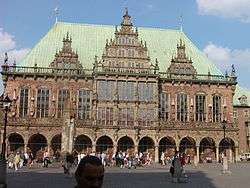 City hall from the market place, Roland in side view | |
| Type | Cultural |
| Criteria | iii, iv, vi |
| Reference | 1087 |
| UNESCO region | Europe and North America |
| Inscription history | |
| Inscription | 2005 (29th Session) |
The Bremen City Hall is the seat of the President of the Senate and Mayor of the Free Hanseatic City of Bremen. It is one of the most important examples of Brick Gothic architecture in Europe. Since 1973, it is protected by the monument protection act.[1] In July 2004, along with the Bremen Roland, the building was added to the list of UNESCO World Heritage Sites.[2]
Locality
The city hall stands on northeastern side of the market square in the historic city centre. Directly in front of it is the statue of Roland, mentioned above. On the opposite side of that square there is the ancient guildhall, called Schütting, still today seat of the board of commerce. On the southeastern side of the square is the seat of Bremen state parliament, called the Bürgerschaft. East of both, town hall and parliament, Bremen Cathedral is located. Near the northern corner of the town hall, the sculpture of the The Town Musicians of Bremen (by Gerhard Marcks) has been placed. North of it, there is the Church of Our Dear Lady ("Kirche Unser Lieben Frauen" or short "Liebfrauenkirche").
History
The ancient town hall
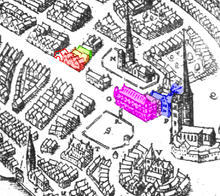
pink = Gothic town hall
blue = archbishop's palace
red = adaptions or descessors of the ancient town hall
red outline = dismantled arch,[3]
green = descessor buildings of the ancient office
yellow = probable other relics or descessors of the ancient town hall group
Bremen's first town hall had been situated in the southern end of the block between Liebfrauenkirchhof ("Our Dear Lady's Churchyard"), Obernstraße ("Highstreet") and Sögestraße ("Pigstreet"). In 1229, it was mentioned as "domus theatralis" ("show house"), since 1251 repeatedly as "domus consularis" ("councilars' house"). An arch across Sögestraße and a repair by a mason suggest a stone building, and already existing before the arrival of Gothic style it must have been erected in Romanesque style. It is assumed that before the municipality gained a certain autonomy, the building served as a law court and therefore had at least one open hall, as old Saxon law forbade trials to be held in closed rooms. An exact description is not available, but several documents tell about the cloth shops, there. They describe localizations "sub" ("below") the town hall and the office. Dependant to the interpretation of "below" as "in the hall below …" or "in front of the basement of …", the documents suggest very different settings of the town hall and its environment. Two texts tell of a stair or staircase of the house at Liebfrauenkirchhof.
After the construction of the new (nowadays old) town hall, it was hired out to the grocers' guild, than as a hobs store. Finally in 1598, it was sold to two particular owners, who converted it to or replaced it by their private houses.
The Gothic town hall

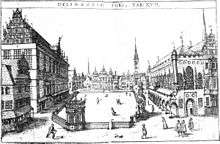
.jpg)
At about 1400, when the municipality of Bremen politically was on top, a new town hall was planned and built. Most engaged were the burgomaster, Johann Hemeling, the councillars Friedrich Wagner an Hinrich von der Trupe. Localization and shape were a demonstration of municipal power against the archbishop. Bremen Market Square, completely plastered since about a century before, was now dominated by the town hall rather than by the cathedral and the archbishop's palace. Both of its two halls, the upper hall and the lower hall, were a few inches longer and wider than the great hall of the episcopal palace. Alike there, the entrances were in the ends. There was (and is) no porch to the market square itself. The wine cellar is below those halls, but a bit subdivided.
With the construction of the town hall, the first Roland sculpture was erected in front of it. It was not yet as large as today.
The town hall in Gothic style was decorated with 16 large sculptures, showing emperors and prince-electors, demonstrating Bremen's claim of being an imperial city, and four ancient philosophers (probably originally four prophets). But at the same time it was fortified; there were two wall-walks, one above the gallery towards the market square and one all around the gutters of the hip-roof. Four small towers with staircases served the access from the upper hall to the upper wall-walk. The gallery on ground level towards the market square during the first centuries was no shelter for merchants, it was reserved for trials.
On the rear side of the gothic town hall, there was an extension, in the upper flour containing the room for the city council, called (old) Wittheits-Stube, i.e. Council Chamber. West of it, there was an outer staircase from Our Dear Lady's Churchyard to the upper hall.
After the Rebellion of the 104 Men in 1432, the outer staircase was removed. In the end of 15th century, an office was built below the old Wittheits-Stube.
Renaissance
In 1545 to 1550, an extension with three floors, containing a new Wittheits-Stube and offices, was built between the town hall and the archbishop's palace, showing a Renaissance style gable eastward facing the cathedral.
In the end of the century, Bremen lived through its second boom, and a great relaunch of the town hall was headed. The main artist was the architect and mason Lüder von Bentheim. The modernization took place in two steps. In the first step, 1595 to 1596, the ten windows of the upper hall towards the market square were converted from pointed arches to large rectangular windows. About twelve years later, in 1608 to 1612, a great transformation to Weser Renaissance was started: The two middling windows and the proclamation door between them were displaced by a huge avant-corps, consisting of slim pilars and columns and large windows. On top, a decorated gable in Flemish Renaissance was erected, two similar gables beside. The façade was decorated with a lot of reliefs. Many architectural elements based on masters of the Dutch Renaissance, such as Hans Vredeman de Vries, Hendrik Goltzius and Jacob Floris. The covers of the wall-walks were displaced by decorative balustrades.
Baroque
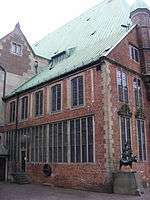
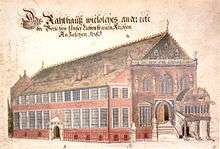
Soon after the completion of those works, Germany was ravaged by the Thirty Years' War, and after the Peace of Westphalia, Bremen had to defend against Swedish annexion campaigns.
In 1682/83, The office on the rear side was enlarged in a very modest kind of Baroque style – with horizontal belts of windows that didn't become common before two centuries later.
19th century
With the German mediatization in 1803, the neighbouring archbishop's palace that had been exterritorial, at last Hanoveran, became a municipal property. Provisionally, it was used for offices at once. In 1818/19, it was partly dismantled and rebuilt as the Neoclassical "Stadthaus" (municipal office building). In 1826, dangerous damages of the representative town hall and its extensions were detected. With the repairs, the appearance of the market front was conserved, but the eastern Renaissance façade was replaced by a simple one and the rear side lost its unique design.
20th century


From 1820 to 1900, Bremen multiplied its population, and, in the decades around 1900, Wilhelminism preferred abundant representation. Therefore, an enlargement of the town hall was planned. In 1909, the Stadthaus was dismantled in order to build the new town hall on its ground. During that work, much more Gothic relics were discovered, than historians and architects had expected. With the "Neues Rathaus" ("New Town Hall"), the town hall in 1909–1913 received an extension about twice as large as the old building. The Munich architect Gabriel von Seidl succeeded to avoid a dominance of his addition. Nevertheless, its three Neorenaissance façades are a very late example of historism. The fourth one, facing the Church of Our Lady and adjacent to the rest of the Baroque extension, is rather Art Nouveau.
By boarding up the outer walls, and due to heroic efforts of the fire brigade, the town hall of Bremen survived the air raids of World War II with little damage, though more than sixty percent of the city was destroyed.
Usage
- As told above, the seat of the Burgomaster of Bremen is in the New Town Hall.
- The Bremer Schaffermahl a traditional annual banquet for the captains, is held in banquet hall of the New Town Hall.
- Many ceremonial events are held in the upper hall of the Old Town Hall.
- The lower hall of the historical building is used for exhibitions, almost continuously.
Main sights
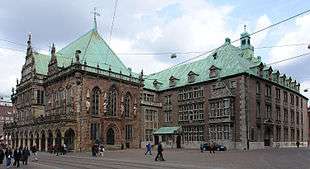
Old Town Hall
- The Upper Hall (Obere Rathaushalle). It is still Bremen's most noble site for meetings.
- The Golden Chamber (Güldenkammer). This small room, added to the upper hall in 1608, was redecorated in 1905 by Heinrich Vogeler in a pure Art Nouveau style. All details and fittings, including door handles, fireguard, chandeliers and the gilded leather wallpaper (cuir de Cordoue) have been selected in this style.
- The Lower Hall (Untere Rathaushalle). This room retains its unadorned original form. In contrast to the upper chamber, this room is plain, with a stone floor, visible timber beams, and limewashed walls. In earlier times, it also functioned as a marketplace for fine-goods such as spices and cloths. Nowadays it is used for exhibitions.
- The Bremer Ratskeller is a public house in the basement, the home of the oldest barrel of wine in Germany, crafted in 1653.
New Town Hall
- The banquet hall
- The fireplace room
- The Gobelin room
- The Senate Hall
Gallery
 Neighbourhood of Bremen's town hall
Neighbourhood of Bremen's town hall Upper Hall
Upper Hall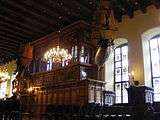 Upper Hall with former archive (upstairs) and Güldenkammer
Upper Hall with former archive (upstairs) and Güldenkammer Upper Hall, "Charlemagne and bishop Ansgar", painted in 1532
Upper Hall, "Charlemagne and bishop Ansgar", painted in 1532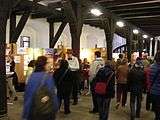 Lower Hall
Lower Hall
 Fireplace in the New Town Hall
Fireplace in the New Town Hall
Sources
- Konrad Elmshäuser: Der erste Roland und das erste Rathaus von Bremen, In: Bremisches Jahrbuch, vol. 84, Bremen 2005, ISSN 0341-9622, p. 9–45
- Rudolf Stein: Romanische, gotische und Renaissancebaukunst in Bremen, Bremen 1962, p. 239–276 und 529–676
References
- ↑ "Database of Landesamt für Denkmalpflege Bremen #0066,T0001". (German)
- ↑ "Town Hall and Roland on the Marketplace of Bremen". UNESCO World Heritage Centre 1992-2013. Retrieved December 5, 2013.
- ↑ drawn after the topographically quite incorrect map by Frans Hogenberg
External links
| Wikimedia Commons has media related to Town hall of Bremen. |
- Official website—(German) + (English)
- UNESCO World Heritage listing for Bremen Town Hall and Roland on the Marketplace of Bremen